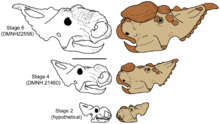Centrosaurinae
| Centrosaurines Temporal range: Late Cretaceous, 84–66 Ma | |
|---|---|
| | |
| Centrosaurus nasicornus skeleton, Palaeontological Museum Munich | |
| Scientific classification | |
| Kingdom: | Animalia |
| Phylum: | Chordata |
| Class: | Reptilia |
| Clade: | Dinosauria |
| Order: | †Ornithischia |
| Family: | †Ceratopsidae |
| Subfamily: | †Centrosaurinae Lambe, 1915 |
| Type species | |
| Centrosaurus apertus Lambe, 1904 | |
| Subgroups | |
| Synonyms | |
| |
The Centrosaurinae is a subfamily of ceratopsid dinosaurs named by paleontologist Lawrence Lambe, in 1915, with Centrosaurus as the type genus. The centrosaurines are further divided into two tribes, the centrosaurins and the pachyrhinosaurins.[1]
Classification
The below species were found to belong in Centrosaurinae by a 2014 publication (unless otherwise noted):[2]
- Centrosaurinae
The cladogram presented here follows a 2012 phylogenetic analysis by Ryan, Evans & Shepherd.[5] Clade names within Centrosaurinae follow Fiorillo & Tykoski (2012).[3]
| Ceratopsidae |
| ||||||||||||||||||||||||||||||||||||||||||||||||||||||||||||||||||||||||||||||||||||
| |
This cladogram follows the phylogenetic analysis performed by Sampson et al. (2013). As is the case above, clade names within Centrosaurinae follow Fiorillo & Tykoski (2012).[3]
| Ceratopsidae |
| ||||||||||||||||||||||||||||||||||||||||||||||||||||||||||||||||||||||||||||||||||||||||||||||||
| |

Reproduction

Possible neonate sized centrosaurine fossils have been documented in the scientific literature.[6] Research indicates that centrosaurines did not achieve fully developed mating signals until nearly fully grown.[7] Scott D. Sampson finds commonality between the slow growth of mating signals in centrosaurines and the extended adolescence of animals whose social structures are ranked hierarchies founded on age-related differences.[7] In these sorts of groups young males are typically sexually mature for several years before actually beginning to breed, when their mating signals are most fully developed.[8] Females, by contrast do not have such an extended adolescence.[8]-265" />
See also
Footnotes
- ↑ Sampson (1995).
- ↑ Csotonyi, J.T.; White, S. (2014). Paleoart of Julius Csotonyi: Dinosaurs, Sabre-Tooths and Beyond. Titan Books. pp. 102–103. ISBN 978-1-7811-6912-4.
- 1 2 3 4 Fiorillo, A. R.; Tykoski, R. S. (2012). "A new Maastrichtian species of the centrosaurine ceratopsid Pachyrhinosaurus from the North Slope of Alaska". Acta Palaeontologica Polonica. 57 (3): 561. doi:10.4202/app.2011.0033.
- ↑ Evans, David C.; Ryan, Michael J. (2015). "Cranial Anatomy of Wendiceratops pinhornensis gen. et sp. nov., a Centrosaurine Ceratopsid (Dinosauria: Ornithischia) from the Oldman Formation (Campanian), Alberta, Canada, and the Evolution of Ceratopsid Nasal Ornamentation". PLOS ONE. 10 (7): e0130007. doi:10.1371/journal.pone.0130007.
- ↑ Ryan, M. J.; Evans, D. C.; Shepherd, K. M.; Sues, H. (2012). "A new ceratopsid from the Foremost Formation (middle Campanian) of Alberta". Canadian Journal of Earth Sciences. 49 (10): 1251. doi:10.1139/e2012-056.
- ↑ "Abstract," Tanke and Brett-Surman (2001). Page 207.
- 1 2 "Retarded Growth of Mating Signals," Sampson (2001); page 270.
- 1 2 "Sociological Correlates in Extant Vertebrates," Sampson (2001); page 265.
References
- Sampson, S. D. (1995b). "Two new horned dinosaurs from the Upper Cretaceous Two Medicine Formation of Montana; with a phylogenetic analysis of the Centrosaurinae (Ornithischia: Ceratopsidae)." Journal of Vertebrate Paleontology, 15(4): 743-760.
- Sampson, S. D., 2001, Speculations on the socioecology of Ceratopsid dinosaurs (Orinthischia: Neoceratopsia): In: Mesozoic Vertebrate Life, edited by Tanke, D. H., and Carpenter, K., Indiana University Press, pp. 263–276.
- Tanke, D.H. and Brett-Surman, M.K. 2001. Evidence of Hatchling and Nestling-Size Hadrosaurs (Reptilia:Ornithischia) from Dinosaur Provincial Park (Dinosaur Park Formation: Campanian), Alberta, Canada. pp. 206–218. In: Mesozoic Vertebrate Life—New Research Inspired by the Paleontology of Philip J. Currie. Edited by D.H. Tanke and K. Carpenter. Indiana University Press: Bloomington. xviii + 577 pp.
External links
| Wikimedia Commons has media related to Centrosaurinae. |


